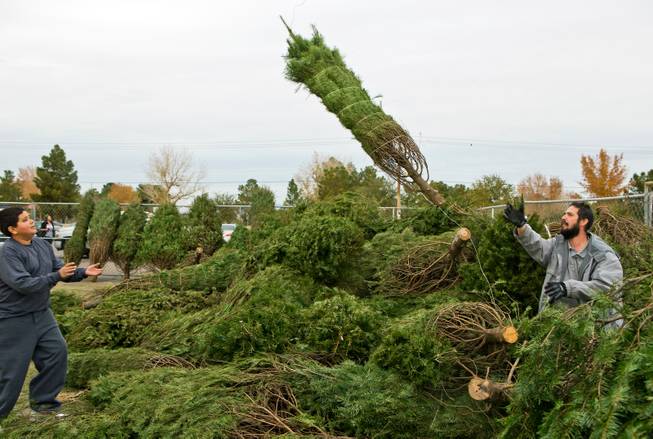
Tony Santos tosses a tree to Joshua Robles as they select from hundreds of free Christmas trees dropped off by a vendor at Sunset Park in 2014. Prices of Douglas firs this year are generally higher than recent seasons because fewer were planted in reaction to a glut in the Pacific Northwest about a decade ago.
Thursday, Dec. 15, 2016 | 2 a.m.
Steve Phillips and his family venture up to Oregon every year in August, a picturesque time of year to visit the verdant Pacific Northwest.
The trip offers no vacation for Phillips, though. He walks his preferred plantation and surveys more than 40,000 trees to select the 3,000 he wants to sell at Deerbrooke Farms, his Christmas tree lot in the northwest part of the Las Vegas Valley.
“He allows us to cherry-pick his plantation,” Phillips said. “We go out there and put a ribbon on every one we want.”
This year, Phillips discovered early in the process that tree prices would shoot upward, as growers in Oregon and Washington charge more for a scarcer supply of the most popular varieties, especially Douglas firs.
“The pendulum swings about every seven years,” Phillips said. “It swings for the buyer and then in seven years, it swings in favor of the grower.”
Growers appear to stand on the positive side of that swing this year, in part because fewer overall trees were planted in major growing states like Oregon and Washington following a glut that began in 2008, according to Hugh Whaley of the National Christmas Tree Association (NCTA). That shortage leads to higher prices not just in Nevada, but throughout the region.
“We kind of anticipated that the cost would go up,” Whaley said. “Things are kind of getting back into equilibrium.”
Deerbrooke Farms offers its 6- to 7-foot Douglas firs for $70 this year, a price increase from last year. Similarly sized Noble firs — considered a more premium product — sell for $90.
“This is very strange,” Phillips said. “The customer is looking at the price of the Douglas fir and saying, ‘Jeez, for $20 more, I can buy a Noble.'”
Phillips said wholesale prices have increased for him each of the past three years and those ultimately ended up reflected in his retail price in two of those years.
“You have to compensate for that 10 percent,” Phillips said of the cost increase from wholesale.
Phillips, a Las Vegas fire captain who employs 40 people in his operation, sells trees ranging from $25 tabletops up to 20-foot room-fillers for $550. Consumers responding to the NCTA's 2015 survey reported spending an average of just more than $50 for a real tree.
That annual survey by NCTA shows that the real-tree industry generated more than $1.3 billion in retail value in 2015. Americans purchased 25.9 million real trees last year, compared with 12.5 million artificial trees at a retail value of $854 million.
Whaley expects a decent 2016 sales report, in part because Christmas falling on a Sunday allows for a slightly longer sales season than in other years. Additional factors that can influence total sales include trees available for harvest, harvest conditions, weather conditions, the number of consumers traveling for the holidays, and the number of retail outlets offering trees for sale.
Phillips expects another change in availability and pricing when growers respond to this year's change.
“Now what the farmers are going to do next year is plant as many Douglas firs as they can, so the Nobles suffer because there’s only so much land,” Phillips said.

Join the Discussion:
Check this out for a full explanation of our conversion to the LiveFyre commenting system and instructions on how to sign up for an account.
Full comments policy